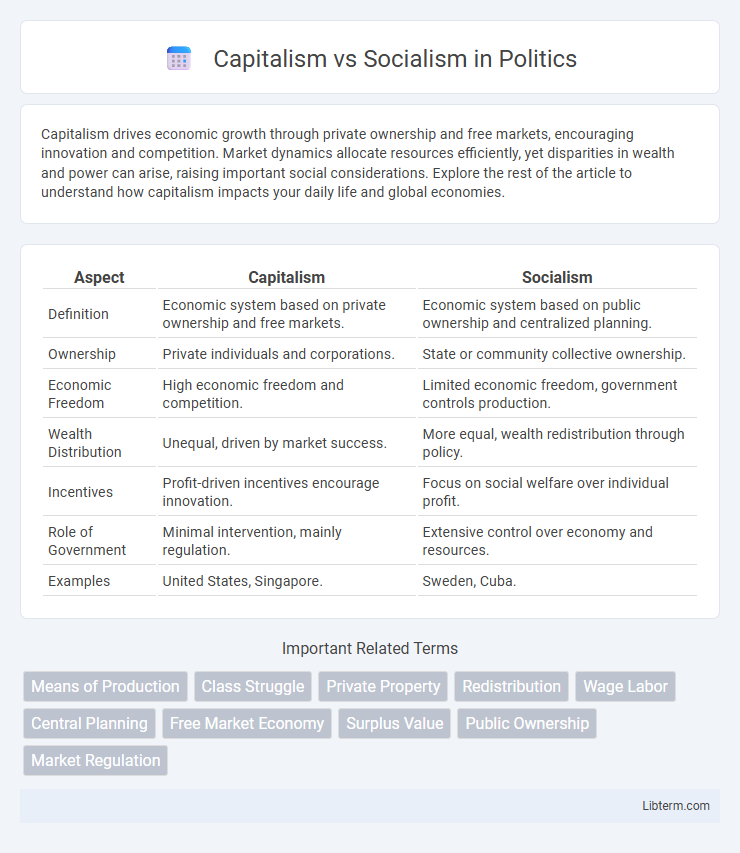Capitalism drives economic growth through private ownership and free markets, encouraging innovation and competition. Market dynamics allocate resources efficiently, yet disparities in wealth and power can arise, raising important social considerations. Explore the rest of the article to understand how capitalism impacts your daily life and global economies.
Table of Comparison
| Aspect | Capitalism | Socialism |
|---|---|---|
| Definition | Economic system based on private ownership and free markets. | Economic system based on public ownership and centralized planning. |
| Ownership | Private individuals and corporations. | State or community collective ownership. |
| Economic Freedom | High economic freedom and competition. | Limited economic freedom, government controls production. |
| Wealth Distribution | Unequal, driven by market success. | More equal, wealth redistribution through policy. |
| Incentives | Profit-driven incentives encourage innovation. | Focus on social welfare over individual profit. |
| Role of Government | Minimal intervention, mainly regulation. | Extensive control over economy and resources. |
| Examples | United States, Singapore. | Sweden, Cuba. |
Introduction to Capitalism and Socialism
Capitalism is an economic system characterized by private ownership of the means of production, market-based allocation of resources, and profit-driven enterprises, fostering competition and innovation. Socialism emphasizes collective or governmental ownership and control over production, aiming to reduce economic inequality through wealth redistribution and planned resource allocation. Both systems present distinct approaches to property rights, economic coordination, and social welfare policies.
Core Principles of Capitalism
Capitalism is based on private ownership of the means of production, emphasizing voluntary exchange and competitive markets to drive economic growth. The core principle of profit maximization incentivizes innovation, efficiency, and wealth creation, while individual property rights and free enterprise support consumer choice and market-driven supply and demand. Capitalism relies on limited government intervention to maintain market balance and protect individual freedoms within the economic system.
Fundamental Tenets of Socialism
Socialism prioritizes collective ownership of means of production, aiming for equitable resource distribution and reducing income inequality through state or communal control. It emphasizes social welfare programs, universal access to essential services like healthcare and education, and democratic planning to meet the population's needs. Unlike capitalism's market-driven approach, socialism focuses on cooperation over competition to foster economic stability and social justice.
Historical Background and Evolution
Capitalism originated during the late Middle Ages and Renaissance, driven by the rise of mercantile trade and the Industrial Revolution's technological innovations, which fostered private ownership and market competition. Socialism emerged in the early 19th century as a response to industrial capitalism's inequalities, influenced by thinkers like Karl Marx and Friedrich Engels, advocating for collective ownership and wealth redistribution. Throughout history, capitalism and socialism have evolved through various adaptations, with capitalism emphasizing free markets and innovation, while socialism has seen diverse implementations from democratic socialism to state-controlled economies.
Economic Efficiency and Productivity
Capitalism drives economic efficiency and productivity through competition and profit incentives, encouraging innovation and resource allocation based on supply and demand. Socialism emphasizes equitable resource distribution and state control, which can reduce market-driven efficiency but aims to minimize economic inequality. Empirical studies indicate capitalist economies generally achieve higher GDP growth rates and innovation outputs, while socialist systems often experience slower productivity growth due to reduced competitive pressures.
Income Inequality and Wealth Distribution
Capitalism often results in significant income inequality due to its emphasis on private ownership and market-driven wealth accumulation, enabling the richest individuals to amass vast fortunes while lower-income groups face stagnant wages. Socialism aims to reduce income inequality by promoting wealth redistribution through progressive taxation, social welfare programs, and public ownership of key industries, fostering more equitable access to resources and opportunities. Empirical studies reveal that countries with stronger socialist policies typically exhibit lower Gini coefficients, indicating more balanced income distribution compared to predominantly capitalist economies.
Role of Government and Regulation
Capitalism emphasizes limited government intervention, prioritizing free markets where supply and demand dictate economic outcomes, fostering innovation and competition. In contrast, socialism advocates for significant government regulation and ownership of key industries to ensure wealth redistribution and social welfare. The extent of government control in socialism aims to reduce economic inequality, while capitalism views minimal regulation as essential for efficient resource allocation.
Social Welfare and Public Services
Socialism prioritizes social welfare by emphasizing universal access to healthcare, education, and affordable housing through government-funded public services. Public services under socialism are designed to reduce income inequality and provide a safety net for all citizens, ensuring basic needs are met regardless of economic status. Capitalism, in contrast, often relies on market-driven solutions where social welfare programs may be limited or means-tested, resulting in varied access and quality of public services.
Global Perspectives and Case Studies
Capitalism drives economic growth through market competition and private ownership, evident in the United States' high GDP and innovation rates. Socialism emphasizes wealth redistribution and social welfare, as seen in Nordic countries like Sweden, which boast strong social safety nets and low income inequality. Comparative case studies reveal that mixed economies, such as Germany, balance capitalist market dynamics with socialist-inspired social programs to achieve stable growth and social equity.
Contemporary Debates and Future Outlook
Contemporary debates on capitalism versus socialism center around economic inequality, wealth distribution, and the role of government in market regulation. Advocates for capitalism emphasize innovation and individual freedom, while proponents of socialism argue for social welfare and reduced disparities through state intervention. The future outlook suggests a hybrid model may emerge, combining free-market efficiencies with robust social safety nets to address evolving global challenges.
Capitalism Infographic

 libterm.com
libterm.com